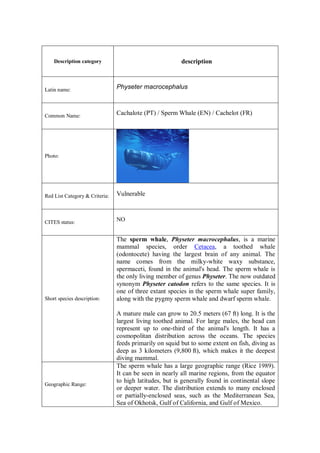
Cachalote
- 1. Description category description Latin name: Physeter macrocephalus Common Name: Cachalote (PT) / Sperm Whale (EN) / Cachelot (FR) Photo: Red List Category & Criteria: Vulnerable CITES status: NO The sperm whale, Physeter macrocephalus, is a marine mammal species, order Cetacea, a toothed whale (odontocete) having the largest brain of any animal. The name comes from the milky-white waxy substance, spermaceti, found in the animal's head. The sperm whale is the only living member of genus Physeter. The now outdated synonym Physeter catodon refers to the same species. It is one of three extant species in the sperm whale super family, Short species description: along with the pygmy sperm whale and dwarf sperm whale. A mature male can grow to 20.5 meters (67 ft) long. It is the largest living toothed animal. For large males, the head can represent up to one-third of the animal's length. It has a cosmopolitan distribution across the oceans. The species feeds primarily on squid but to some extent on fish, diving as deep as 3 kilometers (9,800 ft), which makes it the deepest diving mammal. The sperm whale has a large geographic range (Rice 1989). It can be seen in nearly all marine regions, from the equator to high latitudes, but is generally found in continental slope Geographic Range: or deeper water. The distribution extends to many enclosed or partially-enclosed seas, such as the Mediterranean Sea, Sea of Okhotsk, Gulf of California, and Gulf of Mexico.
- 2. Range Map: http://mapservices.iucnredlist.org/IUCN/mapper/index.html? ID_NO=41755 The greatest threat to sperm whales, extensive commercial whaling, has ceased. However, a number of other threats of various dimensions remain. Entanglement in fishing gear, particularly gillnets, has been a particular problem in the Mediterranean Sea, but sperm whales die from entanglement in nets and lines in many other areas and in a variety of fisheries as well. Sperm whales sometimes take fish off fishing gear (most often demersal long-line gear), an activity known as “depredation.” Depredation of long-line catches appears to Major Threat(s): be a recent and increasing phenomenon, and now occurs in many regions (e.g., South East Alaska, Chile, South Georgia and several other southern ocean island areas, North Atlantic). This interaction has resulted in a few reported entanglements and deaths, and has incurred hostility from some, including shooting of whales. Sperm whales face other threats at a more regional level. These include collisions with ships, for instance off the Canary Islands and in the Mediterranean, and ingestion of marine debris in the Mediterranean. Management plans need both development and implementation. The International Whaling Commission manages sperm whale populations under the International Convention for the Regulation of Whaling, and Schedule of the Convention lists sperm whale seasons, sperm whale size limits and sperm whale catch limits (0 at present), as well as sanctuaries for all species in the Indian and Southern Oceans. Conservation Actions: However, no scheme for managing sperm whale populations is in place. Moreover, many range states are not members of the International Whaling Commission. Regional subpopulations of sperm whales exist, and there has been an apparent lack of recovery in some areas or even continued decline. Therefore, further assessments of the status of sperm whales should be conducted at the subpopulation level. IUCN base link: http://www.iucnredlist.org/apps/redlist/details/41755/0 http://www.iucnredlist.org/apps/redlist/details/41755/0 http://en.wikipedia.org/wiki/Sperm_whale Sources: http://www.horta.uac.pt/projectos/MSubmerso/old/200006/C achalotes.htm
